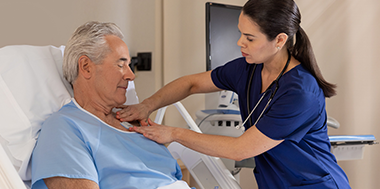BioButtons Make Breakthroughs in Supporting Care Teams
All-too-familiar scenarios during a patient’s stay: a groggy patient, frequent beeping and creeping in the night, and hearing “I’m here to check your vital signs, again.” Then, there’s waiting for data, and sometimes, the unexpected patient decline.
However, since April 2023, Houston Methodist has made strides to improve the patient experience, enhance our operations and foster better patient outcomes with the use of BioIntelliSense BioButtons.
Big benefits in small packages
The BioButton is a medical grade wearable device, about the size of a quarter, that continuously monitors certain patient vitals in real-time, up to 1,440 readings per day. This includes measures, such as temperature, respiratory rate and heart rate at rest, body position, sleep performance and activity state.

The data is continuously added to each patients’ chart in Epic, where the care team can access reports illustrating the progress of their patients’ vital sign readings over time. The system can be programmed to send alerts if those readings leave specified ranges, too.
Not quite an “Easy Button” but close
With initial deployments last spring in four units– Walter Tower 17 and 18, Dunn 4 West and Main 8 North — BioButtons have been rolled out in all non-ICU inpatient units systemwide. There are more than 2,000 devices currently in use.
“Staff appreciate knowing that even when they aren’t in the room with a patient, data collection and centralized monitoring is ongoing, so they have more time to provide patients with bedside care and attention,” said Gail Vozzella, senior VP and chief nursing executive.
Since implementing this technology, Vozzella says BioButtons have helped HM revolutionize patient care and anticipate patient needs and better support our staff. And they aren’t replacing human patient monitoring. Instead, they’re enhancing the care team and patient comfort.
Some of the benefits include:
- Enhances the care team – Remote, automated hourly vitals collection enables a virtual remote monitoring team to act as an extra set of eyes and ears, providing a “safety net” for the bedside team. In-room telemetry EKG devices, collecting patient blood pressure vitals and general rounding protocols are still in place.
- Enables early detection of issues and decline – Frequent vitals monitoring enables many more data points to be gathered over time. An algorithm reads the data and picks up trends, which not only allows early detection of possible patient issues or deterioration, but in some instances, it also may identify previously undiagnosed conditions. A central remote monitoring team is also in place to take data-driven action as needed.
- Improves patient comfort – Since data is available in real-time and remotely, patients appreciate fewer interruptions during the night from manual vitals, allowing them to get more sleep or rest. This is an improvement from the previous four to six/eight-hour manual data collection intervals.
Other benefits, convenience
The device provides advanced analytics at a fraction of the cost of spot temperature measurements or traditional Remote Patient Monitoring (RPM) systems. According to Healthline, wearable technology implementations are expected to reduce hospital costs by 16% in 2027. By 2037, remote patient monitoring devices could save $200 billion.
It’s designed to be used once per patient with a battery life of one to three weeks. It can stay on the patient for baths and most procedures, but is removed if the patient is discharged, transferred to another unit or goes to the Cath Lab, MRI or surgery. If the patient is returning to the unit, special storage cubbies for the BioButton are available in each patient room and the BioButton is reapplied when the patient returns from the procedure.
After use, each BioButton is collected in a special bag to be returned to the vendor and reprocessed for future re-use.
Expanding BioButton use
In the coming weeks, the use of BioButton monitoring will be implemented in the HMH emergency department for admitted patients. Plans are also in development to expand the remote monitoring program, including sending some patients home with a BioButton for continued monitoring after a hospital stay or visit.
Globally, more research is currently underway on how wearables can help monitor stress patterns in children and even care for people with chronic conditions, including cancer, lung diseases and heart conditions. These technologies are still under development, and it will likely be several years before the general population can use them.
“The potential for wearables in healthcare is truly remarkable,” said Lisa Stephenson, chief nursing informatics officer. “We’re incredibly fortunate to have leadership, talent and resources to be on the leading edge of technology to provide the best experience for patients and the best tools for our healthcare providers to fulfill their mission.”
